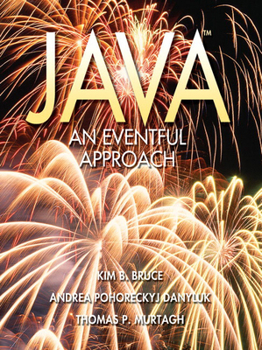Java: An Eventful Approach
Java, an object-oriented language with many standard libraries, offers both complexities and opportunities. This introductory book makes use of a new approach to understanding programming in Java. KEY TOPICS: Provides an objects-first approach to programming. Introduces object-oriented graphics and writing methods early in the book. Motivates readers to use event-driven programming. Reinforces the importance of understanding several...
Format:Paperback
Language:English
ISBN:0131424157
ISBN13:9780131424159
Release Date:July 2005
Publisher:Pearson
Length:720 Pages
Weight:3.65 lbs.
Dimensions:1.1" x 7.1" x 9.1"
Customer Reviews
2 ratings
Java: An Eventful Approach Review
Published by Thriftbooks.com User , 17 years ago
It's a good book overall. It offers a more practical approach to object-oriented programming. The fun excercises challenged me enough to make me confident in each lesson. However, because it's only a first edition, there were numerous spelling and syntax mistakes. Nonetheless, I learned an incredible amount about Java and have now found a new hobby.
starts off immediately with objects and graphics
Published by Thriftbooks.com User , 18 years ago
The authors have taken an interestingly different pedagogy to teaching Java to someone totally new to it, or indeed new to any programming language. Most texts on Java start off with describing the simple syntax, like for performing arithmetic, or inputting or outputting a string. These must necessarily be done within at least one class, since Java is very strict about this. But this approach is essentially the same as for earlier non-object oriented languages like C or Fortran. Typically, only later in such a Java text will object oriented discussions arise, or the use of graphics. The novelty offered in this text is to emphasise from the very first chapter the object oriented nature of Java. This is aided by the use of graphics classes. The authors chose graphics because these give an immediate visual feedback to the student, that is very intuitive. This tight feedback loop can aid understanding or even the interest of the student. The two issues are often related! Also, they do the student a favour by simplifying what can admittedly be a confusing melange of associated graphics classes, when you attach a Listener to a Java graphics object. Because then you usually need to write a class that implements that Listener interface, even if you won't be using all the methods. All this is needed under Java. But the authors finesse it by providing a class library which they call objectdraw. It lets the student focus on the key graphics ideas without tripping over the boilerplate. Later in the text, it reveals the usual gory details of what normally has to be done. Hopefully, the student will be experienced enough by then to take this in stride. Another bonus about this book is that through its examples of an Integrated Development Environment, it encourages the student to adopt the free Eclipse. Thus far, Eclipse has been mostly used by experienced Java professionals. But it has very powerful helper facilities. Pushing it down to new programmers may well help them.






